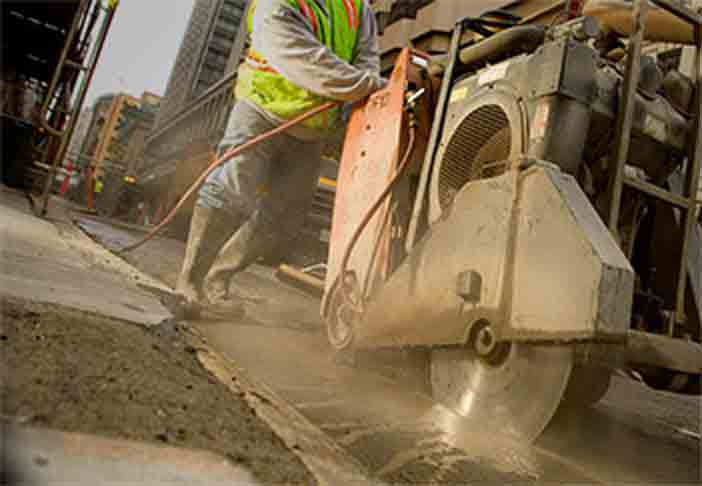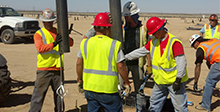OAK + BART
Flatiron Builds the Oakland Airport Connector
After more than 40 years of discussions, studies, and plans, the San Francisco Bay Area Rapid Transit District (BART) will put a much anticipated missing link of their transportation system into service in the next few months. Uniting BART’s Oakland Coliseum station to the Oakland Airport, this long-awaited transit system connection is known as the Oakland Airport Connector (OAC). This 3.2 mile transit system is being built by the joint-venture team of Flatiron/Parsons/Doppelmayr.
As with most public infrastructure projects much of the long delay to building the connector was money. A solution arrived when the Alameda County voters’ reauthorized the county’s half-cent transportation sales tax, known as Measure B. Measure B passed with nearly 82% of the vote and dedicated public funds to a series of transportation projects, including the OAC.
After the initial financing was in place, BART’s Board of Directors still had to certify the Final Environmental Impact Report (EIR) and choose the type of transit system that would be built. In March of 2002, the Board approved the Final EIR (20 years after the Draft Environmental Impact Statement) and selected an elevated Automated Guideway Transit (AGT) system as the preferred mode of transit.
Before a Request for Proposals (RFP) could be issued, the project again ran into funding issues with the loss of some $70 million in federal stimulus funds. During that time, the transit agency considered a public-private partnership to meet financing requirements. The public’s disagreement to the partnership eliminated that as a solution. Eventually BART found other source of funds, including state transportation funds, and a BART reserve account, among others. All told, nine local, state, and federal public agencies provided funds to secure the OAC’s future.
In May 2009 BART issued a RFP for a Design-Build and Operate-Maintain contract. From there, four joint ventures were short listed, but only three submitted a proposal. The winning submission from Flatiron/Parsons/Doppelmayr came in at $440 million.
Flatiron and Parsons handled the design-build portion of the contract while Doppelmayr Cable Car was in charge of the 20-year operate-maintain component. The technology offered by the winning team utilizes a cable and pulley system running on an elevated steel truss guideway. Interestingly, Doppelmayr, an Austrian based company, is best known for applying this technology to ski lifts and gondolas, most notably at the Winter Olympics in Sochi.
The notice of intent to award was issued in December of 2009, but it wasn’t until September 2010 that the joint-venture team was finally awarded the project and given the notice to proceed.
Work finally began with soil investigations in December 2010. Within a few months, utilities started to be protected and moved. By the middle of 2011, as utilities were relocated, pile driving for the foundations of the stations, the maintenance and storage facility, and guideway foundations began.
Design of the guideway called for 124 concrete pier caps and support columns to be built. Some of the pier caps were required to be straddle bents and used two column supports in order for the pier to straddle Hegenberger Road, which runs below much of the guideway. At its maximum, the support columns raise the people mover to a height of 50 feet when it crosses Interstate 880.
As construction on the guideway columns progressed through 2011, the work on the Coliseum Station, Airport Station and maintenance and storage facility was not far behind. In the first half of 2012, the concrete forms for the stations and maintenance facility were put in place and soon after the buildings started to take shape. All told, the columns and station buildings required the placement of 30,000 cubic yards of concrete.
Even though the BART’s Board of Directors selected an elevated guideway, this system doesn’t just run above ground. At Doolittle Drive, designs called for the OAC to go underground for nearly 200 feet. In mid-2012, the short tunnel was constructed using cut and cover style excavation. So that Oakland Airport passengers would be inconvenienced as little as possible by roadway detours, crews worked quickly and got the surface streets back to normal in just a few months.
Installation of the steel truss guideway, on which the passenger vehicles moves, was continuous during the construction of the tunnel and support columns. The final steel truss was installed in late 2013. Soon after, in early 2014, BART began running test vehicles on the track. As final system testing and construction of the stations and maintenance facility wrap up, the OAC is on schedule to carry the first fare-paying passengers in November.
No project of this size is built alone. The bulk of the construction work was handled by Flatiron and its crews, but more than 70 subcontractors contributed to this undertaking. Some of the companies that contributed significant hours to the project include Turner Construction Company, Baines Group, Contra Costa Electric, Danny’s Construction Co., R & W Concrete, Stoloski & Gonzalez, and Flatiron Electric Group.
The large number of subcontractors, several occasions of night work and many lane closures for I-880 and the surrounding surface streets, took significant coordination. Dave Horn of Flatiron stated, “The ability of the subcontractors and crafts to work together in an organized and team-like manner helped Flatiron meet the project’s timeframe and budget goals. We are pleased that a significant number of local and small businesses contributed to the success of this project.”
A substantial, non-construction challenge of the project was the local-hire requirements put in place by BART. One goal, the ‘Local Area Resident’ had a 50% target for project man-hours to be worked by citizens of Alameda County and the three surrounding counties of San Francisco, Contra Costa and San Mateo. A second goal, known as ‘Project Local Impact Area,’ obligated 25% of the projects’ man-hours to go to City of Oakland residents. Through April 2014 Flatiron was meeting both local-hire objectives. In fact, the project was beating the Local Area Resident goal by more than 20%.
The Laborers’ Union was a significant ally for BART and Flatiron to attain the local-hire targets. “The commitment of the Laborers’ Union, as well as the other trades, to help meet the local-hire goals is greatly appreciated,” notes Keonnis Taylor-Flores of BART. “Not only does this project provide a vital connection between two transit systems, it provided good-paying, career opportunities to the residents of Oakland and surrounding communities.”
To date, 394 LIUNA members worked more than 147,000 hours on the project. Local 304, 261 and 324 members accounted for nearly 25% (116,026 hours) of the total Local Area Resident man-hours. Furthermore, Local 304 members worked more than 57,000 hours (31% of total) toward the Project Impact Area goal.
Laborers’ Local 304 Business Manager Fernando Estrada states, “Our members take great pride in the work they do. The opportunity for them to demonstrate their professionalism on a daily basis while building the Connector, a key part of the Bay Area’s public transportation infrastructure, is not taken lightly.”
When in service, the automated guideway transit system will use driverless cars, also known as bogies, to transport riders. The bogies are moved from the station to the maintenance and storage facility, also known as the wheelhouse, by grabbing a cable that is looped between the two. The wheelhouse acts as the central hub in the system and pulls the bogies to and from the stations utilizing 12-foot motorized wheels. In all, four cables pull the bogies 1.5 miles from the Oakland Airport to the wheelhouse, then 1.7 miles to the BART Oakland Coliseum Station and back again.
Once complete, OAC will replace AirBART, a bus service running between the Oakland Airport and BART’s Coliseum Station. AirBART has been plagued by many problems over the years, including extended wait times caused by traffic congestion, confusing and inconvenient ticketing procedures, and a ridership that could soon out-pace its capacity to provide reliable service. Based on prior growth and the future expansion plans at the Oakland Airport, the OAC will alleviate many existing and future transportation issues and create a seamless train to plane connection.
BART is a 104-mile, heavy-rail public transit and subway system that connects San Francisco to Oakland and many other communities throughout the San Francisco Bay Area. It is the fifth busiest transit system in the United States.







